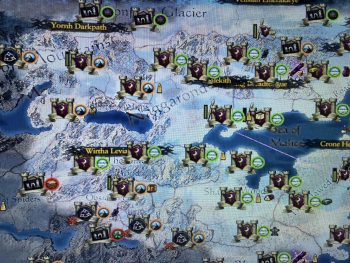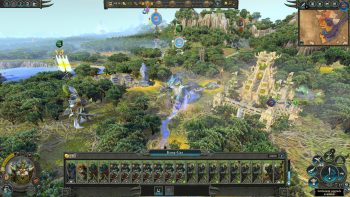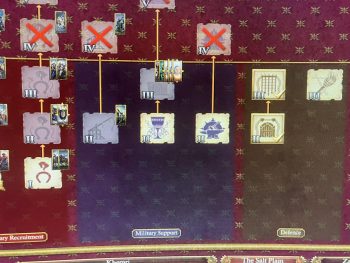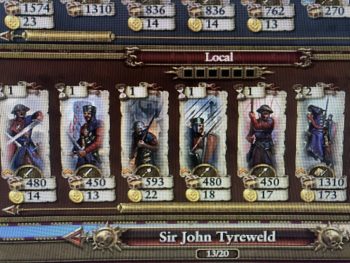Guns or Butter? – Total War: Warhammer II
 I came to Total War way back when, through TW: Rome. Arriving in 2004, it was the third game in the TW series, after Shogun, and Medieval. I liked it, though I wasn’t addicted – as I was to many games back then. But it was fun marshaling armies, and then marching them out to crush your enemies. I talked about it a little bit a few weeks ago in my RTS overview (man, Myth: The Fallen Lords was such a great game!).
I came to Total War way back when, through TW: Rome. Arriving in 2004, it was the third game in the TW series, after Shogun, and Medieval. I liked it, though I wasn’t addicted – as I was to many games back then. But it was fun marshaling armies, and then marching them out to crush your enemies. I talked about it a little bit a few weeks ago in my RTS overview (man, Myth: The Fallen Lords was such a great game!).
Sort of the “What is best in life?” response from the first Conan movie with Ah-nuld:
“To crush your enemies, see them driven before you, and to hear the lamentations of their women.”
There have been over a dozen incarnations, with the Egyptian-themed Pharaoh just dropping in 2023. What I’d LOOOOOVE, is for them to get the license from the Tolkien Estate and do TW: Middle Earth. I enjoyed Battle for Middle Earth I (never played II). But even a decently-done TW: Middle Earth would be FANTASTIC!!!!
Anywhoo. I’ve never done the Warhammer thing, but TW: Warhammer I came out in 2016. And TW: Warhammer II followed the next year. WH II has become the rabbit hole I periodically jump down. This game is – as my buddy Tony dubbed Diablo II long ago – electronic crack.
If you have WH I, you can use those factions/lords some in WH II. But you don’t need them at all. And while the base game is more than enough, part of the TW fun is buying the DLC – they add heroes, factions, and even a few campaigns. I don’t have WH III, but I the model is the same.
I have all the DLC for both WH I, and II. They are frequently 50% off+ on sale. Total War keeps ‘old’ product at original prices. It’s an annoying business model, and they do a boatload of DLC. But the base games have more than enough content. I just like the extra stuff to check out. And you don’t have to buy it, off course.
The Game
 Some basics about Total War – at least, the Warhammer II version. The principles of the series are generally the same. You know what you’re getting, but the engine has evolved over the years. Warhammer II is pretty similar to I. I have not played III yet. I tried to go back to Rome Remastered earlier this year, and that old engine just didn’t work for me anymore.
Some basics about Total War – at least, the Warhammer II version. The principles of the series are generally the same. You know what you’re getting, but the engine has evolved over the years. Warhammer II is pretty similar to I. I have not played III yet. I tried to go back to Rome Remastered earlier this year, and that old engine just didn’t work for me anymore.
The general concept is you take charge of a faction (Elves, dwarves, vampire pirates, etc. In other games it’s Roman families, or medieval countries. You get it).
You build up settlements, and armies on a unit basis, for your faction. You can choose to fight the battles yourself (usually advantageous in outcome) or use auto-resolve. I find the battles time-consuming and not that much fun, so I auto-resolve. The benefits of auto-resolve seem to be reduced from winning the actual fights yourself, though.
Terrain matters in battles, and also on the global map. Dwarven settlements thrive in mountain regions. The vampire lords corrupt the land, making it less/unsuitable for some factions. The lizardmen are primarily in the jungles. So, the faction you choose often impacts what part of the world you start in, and where you choose to expand to.
You attack other armies, and settlements, or colonize ruined ones. You build them up, gaining advantages if you control all the settlements in a single province. You have to balance chasing quests, conquering settlements, and being strong enough on defense to protect what you already have. Random wandering warherds, or rogue armies (frigging pirates) can seriously blow up your plans.
You can form military alliances (as can your enemies), and when you’re strong enough, you can make a confederation with a same-race faction: absorbing all their assets – and their financial obligations!
I just keep playing and trying to expand without a debacle happening. The first ten to fifteen turns usually indicate whether I’m gonna be able to make a go of it with this faction.
Two Game Options
The base campaign is Battle for the Vortex. There are game-given quests, and faction quests as well. You try to build up your settlements and armies, eliminate enemies, and accomplish the various quests. I’ve never made it to the end game. Even on Easy, the computer AI is a pain in the ass. I’ve rarely made it past 100 turns before it got too messed up.
WH II also has a Mortal Empires option. It lets you pick any lord/faction from I or II, and compete against all the other factions. Last one standing wins: No over-arching campaign. I’ve played Mortal Empires a few times, and it’s a neat option, but I prefer playing the official campaign. So….
‘Guns or Butter’
‘Guns or butter’ is an old economic model that shows how governments have to choose between spending for defense or domestic uses. TW play is a variation on that which is pretty much the over-arching element of the game.
You can primarily choose to spend gold on military units, or settlement buildings (there can be a couple other options, like temporary enhancements, but you’re mostly putting your gold into your settlements, or your armies).
And your armies (you start with one, but need multiple ones to survive) have upkeep costs. So, you have a one-time cost to add the unit, then an ongoing cost per turn, to keep it. The bigger your army, and the more advanced the units you use, the greater your upkeep. Which means less gold for your settlement buildings.
Each Province has a capital settlement, with five levels. And except for a couple exceptions, one to three minor settlements, with three levels. You build up your Province Capital, which opens up additional slots for new buildings. There can be a total of ten building slots in a Capital, and there are usually only three additional slots in a minor settlement.
Building Categories

There are different types of ‘chains’ you can pick your settlement upgrades from. I really like this part of game management. And it’s essentially guns or butter. They have different classifications for different factions, but that’s just wording.
Resources – Available in certain settlements. They provide specific goods, like tradable resources (hides, marble, clay), plaques (related to some faction goals), or other benefits. Most settlements do not have this option, so I often take whatever it is. It’s nice when it’s a gold mine, as that is the best source of gold in the game.
Military Recruitment – These produce basic, and advanced, military units.
Basic buildings usually only have three levels, and you can start them when your Province Capital is only first level. They usually offer some other minor benefits, but this is where the meat shields and lower-level units come from. You build your starter armies here.
Advanced buildings usually go up to levels four or five, and provide elite units and enhancements. You need advanced units to get through the middle, and end, games. Purely gun stuff here.
Military Support – These buildings support your armies, lords (Each army is led by a lord), and heroes (a hero is a unique unit that can perform helpful actions and also provides benefits), and settlements. They might make recruitment costs less, reduce your casualty replenishment rates, or let you recruit infantry units with shields. More guns.
Defense – This a limited category, usually letting you add walls to your settlements, or some other defensive improvement for it. I always add walls to smaller settlements, but otherwise, this is my least-used category. As the title implies, this is a defensive category and kind of feels like a mix of guns and butter.
Infrastructure – Here you really get into the guns or butter dichotomy. There’s a wide range of options. Your main gold-making options are here. Also, you can focus on growth (how fast your settlements expand), and public order (if public order gets to-100, you have to put down a rebellion).
There are a lot of options here. Since you only get three additional slots in a smaller settlements, the choices are important. I do try to put up walls in small ones, so, with the Capital building, you only have two free slots. And you’re really choosing between guns and butter.
Misc. -Some settlements have Ports, and some have Landmarks. Ports generate gold and have their own chain. Landmarks are unique to a specific settlement and offer some benefit often worth taking. Even if it’s just a one-level use of a slot.
Choosing Your Building
The game randomly has factions declare war on you. And you can also end up at war with other factions through diplomacy options (that’s part of a follow-up post). You need to build up your first army in a hurry (you start the game with a lord and a small army of five-eight units, usually). Some faction is already pissed at you.
It’s tempting to use an early slot to pick a chain with a new military unit. You can get a more diverse, more effective, army, right out of the gate. Guns over butter.
But you gotta pay for all these troop units, and the constantly being constructed new buildings. So, taking that industrial building with a big per turn revenue, is tempting. The gold mine is a no brainer. In a small settlement (remember, only three slots in addition to the Capital), I almost always choose the max revenue building first. I need that stream started to build that first army.
The third (and last) slot usually goes to walls, which help with defense if you end up under siege. It’s the second slot that lets me shade towards guns or butter. For purposes of this discussion, growth and other things that primarily affect the settlement, or my revenue stream, are butter.
Since the capitals have eight to ten slots, and they go up to level five, I tend to use them for the advanced military buildings, to maximize my firepower. Some support, and non-military buildings go up to level five, so you have to factor that in as well. And walls never hurt.
Technologies
Factions have unique Technology trees. Some are easier to develop than others. But they also reflect the guns or butter dilemma. Especially early on, you can choose technologies (which take multiple terms to develop) to enhance troop unit strength. And also to decrease recruiting costs.
Alternately, technologies that enhance your revenue stream can be vital in providing gold to maintain your growing army. Or building up your settlements.
And any time you can increase your growth or public order, you need to weigh those as immediate needs against those other areas. Butter.
Army Units
 Basic units (like spearmen, or archers) cost a lot less to hire recruit and maintain, than ones such as knights, war eagles, or catapults. The stronger your army, the more it’s gonna cost you. And by mid-game, your main armies had better not still include a bunch of grunts; even if they have leveled up. You needs some higher power units.
Basic units (like spearmen, or archers) cost a lot less to hire recruit and maintain, than ones such as knights, war eagles, or catapults. The stronger your army, the more it’s gonna cost you. And by mid-game, your main armies had better not still include a bunch of grunts; even if they have leveled up. You needs some higher power units.
Armies are capped at a total of 20 units. Do you want a second full-size army? Or two medium-sized ones? Recruit a lord and build a 6 unit army to provide a military presence in a province with falling public order? All those units have an ongoing cost every turn…
You have multiple layers of guns or butter to decide upon. Bad things start to happen if your revenue stream goes negative. And enemies can raid your province, decreasing revenue. Or sack, burn to the ground, or even take over your settlements. And those things can hit your stream.
So, you need to have armies ready not only for attack, but defense. Again – that takes gold.
Wanna hire more lords or heroes? Cha-ching!
In the pic to the right, recruiting a knight will cost about three times as much as recruiting the spearman at arms next to him. But maintaining him each turn will cost ten times more.
So…
Budgeting is the allocation of resources among multiple activities. Total War is strategic and tactical game of allocating resources. And basically, you decided whether to spend your gold on guns or butter. And you need the butter to make more gold. To pay for the guns.
I know folks who like playing out the battles. I have fought my share over the years, and I get it. But the faction management part of the game is what keeps me coming back. Guns or butter.
Crusader Kings
A quick mention of another game.
For a kingdom management-and-war type of game, the Crusader Kings line (three so far) looks to be the standard. I have tried the first game a few times, and it’s got a MASSIVE learning curve. I think it’s manageable, I just haven’t been motivated to master the basics enough to continue on. But it does look like an awful lot of fun if you figure it out.
Next Time
There will be a follow-up Total War post, in which I’m going to talk about how I recently had two of my most successful games by applying principles contained in George Washington’s Farewell Address. That was actually the original intent of this post, but I really enjoyed the guns or butter discussion.
Other Video Gaming Posts
RTS’ and Myth: Fallen Lords
Mount and Blade – Part One
Mount and Blade – Part Two
Steamed: What I’ve Been Playing (December, 2023)
Steamed: What I’ve Been Playing (October, 2022)
Fortnite (one of several mentions)

Bob Byrne’s ‘A (Black) Gat in the Hand’ made its Black Gate debut in 2018 and has returned every summer since.
His ‘The Public Life of Sherlock Holmes’ column ran every Monday morning at Black Gate from March, 2014 through March, 2017. And he irregularly posts on Rex Stout’s gargantuan detective in ‘Nero Wolfe’s Brownstone.’ He is a member of the Praed Street Irregulars, founded www.SolarPons.com (the only website dedicated to the ‘Sherlock Holmes of Praed Street’).
He organized Black Gate’s award-nominated ‘Discovering Robert E. Howard’ series, as well as the award-winning ‘Hither Came Conan’ series. Which is now part of THE Definitive guide to Conan. He also organized 2023’s ‘Talking Tolkien.’
He has contributed stories to The MX Book of New Sherlock Holmes Stories — Parts III, IV, V, VI, XXI, and XXXIII.
He has written introductions for Steeger Books, and appeared in several magazines, including Black Mask, Sherlock Holmes Mystery Magazine, The Strand Magazine, and Sherlock Magazine.